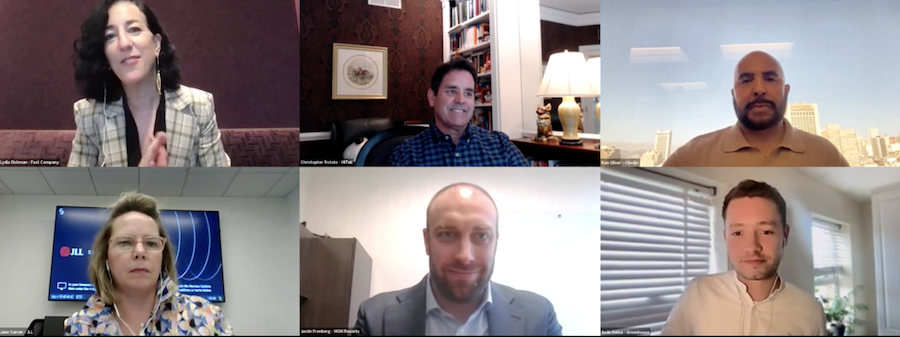Using Innovative Technology and AI to Revolutionize Hiring for Top Talent


Like many other companies, MGM Resorts has been undergoing a talent acquisition transformation over the past few years in the wake of the pandemic and the Great Resignation. “We’re enacting a strategic way for recruiters to evolve into more of an advisor role,” said Justin Fronberg, executive director of talent acquisition for MGM Resorts.
Fronberg spoke during an executive panel discussion about “Using Innovative Technology and AI to Revolutionize Hiring for Top Talent,” during From Day One’s June virtual conference. “What’s been critical for us is to relieve them of the transactional aspects of the position,” he said.
Fronberg told journalist and session moderator Lydia Dishman that using an AI chatbot creates efficiencies for recruiters and job candidates alike. The chatbot allows candidates to determine if an open position is something they are actually interested in without talking to a recruiter, he says.
Some people have reservations about using AI in recruitment, but Jane Curran, global head of talent acquisition at JLL, reminds her team that “you can’t put the genie back in the bottle.” “The tech is here, and we are ready for automation. So why don’t we dig in and find out what works for us, leave the human parts of the job to us, and automate the boring stuff?” she said.
How AI Can Broaden the Talent Pool
If used correctly, implementing AI in recruitment can also reduce bias, says Ken Oliver, vice president of corporate social responsibility at Checkr. “We can focus on things like skill-based learning and the different skill sets that the candidate may have rather than look at things like gender, race, or age, which sometimes come up in the recruitment process,” said Oliver.
AI can also help expand the talent pool by looking beyond more mainstream job boards such as Indeed, says Oliver. “To get the most diverse and inclusive candidates, oftentimes you have to look in some of the most unusual places," he said, noting that this could include social media.
However, AI is “only as good as what you input it with,” he said. For example, if a candidate has a legal record, there’s typically not much understanding “about what that means or what it doesn’t mean, especially when it comes to a specific role.”
But with AI, “we can provide much more context around the candidate and the specific charge, the date of charge, and whether it’s relevant to the job,” Oliver said. This scope can lead companies to consider candidates that they might have traditionally overlooked, says Oliver.
Using AI in the Interview Process
Another way organizations can ensure their workforce is diverse is to standardize the job interview process using AI. “This allows candidates of diverse backgrounds to be evaluated fairly against objective criteria that should be set at the beginning of the process, rather than try to make that up towards the end,” said Seán Delea, team manager of talent acquisition, EMEA at Greenhouse.
For example, a recruiter and a hiring manager will align on a number of key attributes needed for someone to be successful in a particular role and then design an interview process to assess candidates for those attributes objectively, says Delea.
“Then you can do things like use AI to help you generate some of those interview questions. This step alone is helping to reduce human bias when you’re building out the best interview process,” he said.

Christopher Rotolo, VP of global talent at Mitek, says technology has helped standardize the interview process and also write job descriptions. “It literally will pull out the skills and create the interview questions, the guides, the scoring sheets and everything, from soup to nuts,” he said.
The AI technology Mitek uses comes with a package of possible interview questions that the hiring manager and the talent acquisition partner can tweak so “candidates aren’t hearing the same question over and over through the interview process,” Rotolo said.
Some organizations use tools to automate the interview scoring process, even “inferring personality through speech patterns and tone,” Rotolo said. “And I think that will mature. We’ll all be talking about that probably three to five years from now.”
Keeping the Human Element
But even with all of these innovative AI tools, the human touch is still needed, says Curran. For example, when it’s time to promote someone, “You need to know the talent,” she said.
“Who’s the top talent I should be helping make the next move? The connection, the career conversation, the prep, that’s the recruiter’s job,” said Curran.
“[Candidates] want to be treated like a person rather than a number. So, we abide by the stance that AI should assist but not replace humans in the hiring process,” said Delea.
Mary Pieper is a freelance writer based in Mason City, Iowa.
The From Day One Newsletter is a monthly roundup of articles, features, and editorials on innovative ways for companies to forge stronger relationships with their employees, customers, and communities.